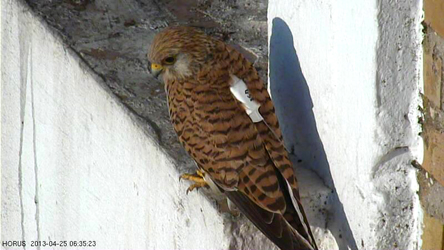Individuals allocate considerable amounts of energy to movement, which ultimately affects their ability to survive and reproduce. Birds fly by flapping their wings, which is dependent on the chemical energy produced by muscle work, or use soaring-gliding flight, in which chemical energy is replaced with energy harvested from moving air masses, such as thermals. Flapping flight requires more energy than soaring-gliding flight, and this difference in the use of energy increases with body mass. However, soaring-gliding results in lower speeds than flapping, especially for small species. Birds therefore face a trade-off between energy and time costs when deciding which flight strategy to use. Raptors are a group of large birds that typically soar. As relatively light weight raptors, falcons can either soar on weak thermals or fly by flapping with low energy costs. In this paper, we study the flight behavior of the insectivorous lesser kestrel (Falco naumanni) during foraging trips and the influence of solar radiation, which we have adopted as a proxy for thermal formation, on kestrel flight variables. We tracked 35 individuals from two colonies using high frequency GPS-dataloggers over four consecutive breeding seasons. Contrary to expectations, kestrels relied heavily on thermal soaring when foraging, especially during periods of high solar radiation. This produced a circadian pattern in the kestrel flight strategy that led to a spatial segregation of foraging areas. Kestrels flapped towards foraging areas close to the colony when thermals were not available. However, as soon as thermals were formed, they soared on them towards foraging areas far from the colony, especially when they were surrounded by poor foraging habitats. This reduced the chick provisioning rate at the colony. Given that lesser kestrels have a preference for feeding on large insects, and considering the average distance they cover to capture them during foraging trips, to commute using flapping flight would result in a negative energy balance for the family group. Our results show that lesser kestrels prioritize saving energy when foraging, suggesting that kestrels are more energy than time-constrained during the breeding season. informacion[at]ebd.csic.es Hernández-Pliego et al (2015) Why Do Kestrels Soar? PLoS ONE DOI: 10.1371/journal.pone.0145402
http://journals.plos.org/plosone/article?id=10.1371/journal.pone.0145402









 Un estudio analiza la distribución de los mosquitos transmisores de la malaria en España
Un estudio analiza la distribución de los mosquitos transmisores de la malaria en España


